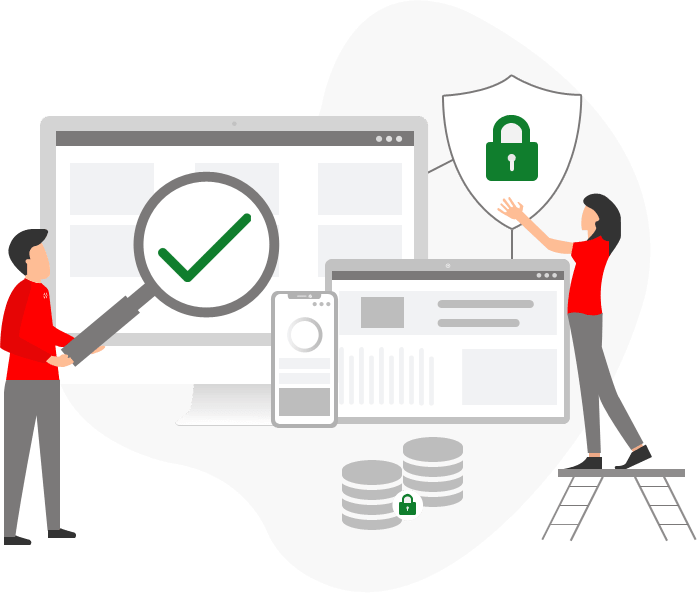Not just a routine software testing process but we make all our efforts to make the product better as well..!
Software Testing
Quality Assurance & Quality Control
Software testing is done before the release to the market or the specific users. Software testing is basically done to see how the software works under different conditions depending on what the software is intended to. Testing is done to understand if the software works correctly or totally fail to work properly. Each test may be used to see how the software works at a point in its functioning. Bad performance, or poor quality, might cause a dis-satisfaction amongst the users which could need more work to be done on the software improvisation. A review of the results of tests may show that some parts of the software may have to be done again, or may go well. Some bad performances or Software bugs may need to be fixed. For larger software systems, tracking may happen checking completeness of the set of tests, test results, and the way quickly any problems are fixed.
All this information is often used for deciding about how ready the software is, and when it might be released to the ultimate audience. Software testing could also be through with separate parts of the software, with a gaggle of those parts, or with the whole software. Software testing could also be done by allowing the software to be employed by a little number of individuals who the software is supposed for, under controlled settings. Testing can be categorised basically as unit testing, white box testing, black box testing, regression testing, manual testing, automated testing, testing tools, test plan, test case, test data and test coverage. Though these tests are more bifurcated accordingly the basic concept of any software testing remain the same.
Software Testing Services
Testing Services
- Manual Testing
- Test Automation
- Functional Testing
- Unit Testing
- Smoke Testing
- Sanity Testing
- Integration Testing
- Interface Testing
- System Testing
- Regression Testing
- User Acceptance Testing
- Non-Functional Testing
- Performance Testing
- Stability Testing
- Load Testing
- Stress Testing
- Compatibility Testing
- Benchmark Testing
- Network Testing
- Web Accessibility Testing
- Usability Testing
- Security Testing
- Reliability Testing
- Localization Testing

Mobile Application Testing
The comprehensive testing or examination of a mobile application pertaining to its functionality, consistent working and performance is termed as mobile app testing. The process can be an automated or manual type of testing. The main lookout while considering the mobile application is that it must be readily available in the respective app store whether IOS, android or other. In an environment where there is an unceasing growth of mobile and hand held devices mobile app testing is a challenging task. Since the similar types of devices are used over wide spread locations testing has to be done considering this aspect as well. This apart there are two main ways of testing mobile applications namely testing on real devices or testing on emulators. However emulators often miss issues that can only be caught by testing on real devices. The display compatibility is one of the crucial aspects in mobile app testing because an application that can work on the high resolution may not work on the lower resolution or vice versa. Finally the user should be able to answer normal phone calls while executing the app and its running.

UX & Usability Testing
Usability testing is a technique used in user intended interaction design to evaluate a product by testing. This is a usual practice, since it gives direct input on how real users use the system. It is more concerned with the planning intuitiveness of the merchandise and tested with users who haven't any prior exposure there to. Since such type of testing is carried out generically the success or an outcome of the functioning of the app creates apprehension among the users that the app will not be functional for a long time. This is the opposite in comparison to the usability methods used to gauge an interface without involving users. Usability testing focuses on measuring a human-made product's capacity to satisfy its intended purpose. Test for the usability or in other words ease of use, of a product is often carried out to ascertain how user friendly is the product in terms of general usage.

Security Testing
Security testing in general is a procedure that is carried out to rectify errors or other mistakes within the safety processes of the data security that protects data. Generally speaking security needs may comprise specific aspects of confidentiality. Actual security requirements tested depend upon the safety requirements implemented by the system. Security testing as a term features a number of various meanings and may be completed during a number of various ways. As such a Security Taxonomy helps us to know these different approaches and meanings by providing a base level to figure from. Confidentiality is a security measure which protects against the disclosure of information to parties other than the intended recipient is by no means the only way of ensuring the security. Integrity of data refers to protecting information from being modified by unauthorized parties. A measure intended to permit the receiver to work out that the knowledge provided by a system is correct. Integrity schemes often use a number of an equivalent underlying technologies as confidentiality schemes, but they typically involve adding information to a communication, to make the idea of an algorithmic check, instead of the encoding all of the communication. Authentication is usually the proving the identity of the user, ensuring that the product is genuine. Authorization is the process of determining that a requester is allowed to receive a service or perform an operation. Access control is an example of authorization. Vulnerability Assessment uses discovery and vulnerability scanning to identify security vulnerabilities and places the findings into the context of the environment under test. However security Assessment is dependent upon assessment of vulnerabilities by incorporating simple manual verifications to ascertain the exposure, but however this does not necessarily mean the probe of weaknesses to gain illegal access.

Load & Performance Testing
The term load testing is employed in several ways within the professional software testing community. Load testing is a term that refers to the process of estimating the usage of a software application by allowing multiple user access to the program simultaneously. As such, this testing is most relevant for multi-user systems; often one built employing a client/server model, like web servers. However, other sorts of software systems also can be load tested. The most accurate load testing simulates actual use, as opposed to testing using theoretical or analytical modelling. Load testing lets you measure a website's level of service and performance whic will be based on the actual behaviour of the visits of the users or the audience. Almost all the load testing equipment follow the classical method of load testing procedures, that is when someone visits the site on the internet, a recorder catches up the communication then creates related inferences. Then a load analyser replays the recorded information, which will later on be used to modify it with different test parameters. In the replay procedure, both the hardware and software statistics are going to be monitored and picked up by the conductor, these statistics include the CPU, memory; disk IO of the physical servers and therefore the reaction time, throughput of the system under test. A load testing report will be generated taking into consideration of the results recorded so far. Load and performance testing analyses software intended for a multi-user audience by subjecting the software to different numbers of virtual and live users while monitoring performance measurements under these different loads. Load and performance testing is typically conducted during a test environment just like the assembly environment before the software is permitted to travel live. A test analyst can use various load testing tools to make these VUsers and their activities. Once the test has started and reached a gentle state, the appliance is being tested at the 100 VUser load as described above. in this way the application’s peak performance and the other aspects can be monitored and recorded for further rectifications . Load and performance testing is especially important if the application, system or service will be subject to a service level agreement or SLA.

Data Integration Testing
Integration testing is conducted to guage the compliance of a system or component with specified functional requirements. this method takes its input modules as that which are unit tested, then categorizes them into larger bits and deliver as its output the integrated system ready for system testing. In this testing most of the developed modules are coupled together to make an entire software or major a part of the system then used for integration testing. This method is extremely effective for saving time within the integration testing process. Nevertheless in case of any discrepancy in recording the results take place then it sure will hamper the entire process making the whole process simply useless and prevents the achieving of the desired test results. So, utmost care and precision has to be followed to achieve the desired inference.

Functionality testing
Functionality testing is conducted to evaluate the compliance of a system or component with specified functional requirements. Functionality testing usually describes what the system does. Since functional testing may be a sort of black-box testing, the software's functionality is often tested without knowing the interior workings of the software. This means that testers don't have to know programming languages or how the software has been implemented. This, in turn, could lead to reduced developer-bias in testing since the tester has not been involved in the software's development. Functional testing does not imply that you are testing a function of your module or class. Testing on the basis of functionality is different from system testing. This verifies that a program can be tested by checking it against a specified system; on the contrary a system testing validates a software program by examining it based on a certain set of parameters. Functionality testing may be a quality assurance process and a kind of black-box testing that bases its test cases on the specifications of the software component under test. Functions are analysed by subjecting them to inputs and confirmation of the inferences of the output.












